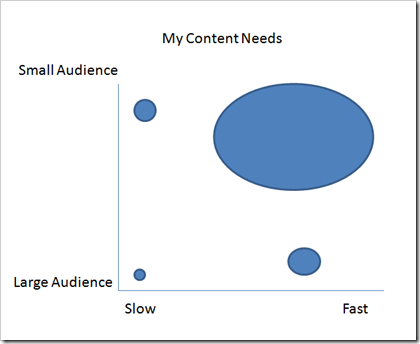This month's #LCBQ is: How do you address the "I want it now!" demand from stakeholders? There are some great responses that can be found by visiting the link above.
Corny 1986 line. :)
Content Needs
This is a very crude self-assessment, but I believe it makes an important point.
If you are reading this, you are a knowledge worker. Consider the content (knowledge, information, learning) you personally need to get your job done. Draw a circle in each quadrant based on the amount (percentage) of the content that you need that's:
- Slow changing vs. fast changing. Will the content remain roughly the same for two years? Or will it really be out of date in two years?
- Large audience vs. small audience. Is the content I need applicable to a relatively large audience or do I have fairly particular needs?
I did a crude version of this for myself and came up with the following:
Definitely the vast majority of the time, I'm needing information that is relatively fast moving and is specific to the particular situations I face. In fact, often the information does really exist. Actually most of us that are Concept Workers will find that we play in that upper right quadrant most of the time.
That said, there are some exceptions that I could think of. For example, I consume a fair bit of content that's around technology. There's a fair amount of it that has a pretty large applicable audience. Of course, most of it is pretty old news in two years time. There is some information around core technologies that will last longer. I also should point out that the information is more specialized all the time, meaning ever smaller audiences. So, that kind of information makes for Fast but Larger audiences.
And when you consider the trends for most concept workers (knowledge workers), we clearly are heading towards faster moving content aimed at smaller audiences.
Workplace Learning's Challenge
Now let's put on the hat of someone in workplace learning. What's our ideal kind of content?
Workplace Learning's ideal content: Slow changing and large audience
How big is that circle? How is that circle doing for most knowledge workers?
This isn't something new, it's just becoming more and more clear. I've discussed it in Disruptive Changes in Learning, Innovators' Dilemma in Learning/eLearning, Business of Learning, and Learning Performance Business Talent Focus.
The reality is that we need to find ways to insert ourselves into the faster moving content and be able to change the dynamics to reach smaller audiences. These relate to speed. One of the nice things about the responses to this month's LCBQ is that they relate directly to speed even though they were not necessarily aimed at the bigger picture above.
Responding to the Need for Speed
I like where Glenn Hansen started his answer:
- Don’t assume that training is the answer.
- Even if some kind of training is reasonable, don’t assume the stakeholder in question has identified the right solution.
And liked Glenn's point about what's required:
Work up your material to the point where it conveys the skills and knowledge needed and where it is professionally presented and fit for purpose. Don’t chase perfection, because it’s more likely your information will be out of date by the time you have it ready.
This is echoed quite a bit by the collection of Agile eLearning - 27 Great Articles that I pulled together previously.
In terms of specific suggestions there are some real nuggets in several of the responses.
Clive has some very good suggestions on speeding things up in The Big Question: How do you respond to the ‘I want it now’ demand?.
Open Sesame's response similarly has some good ideas for rapid solutions.
Jeff Goldman also has several suggestions for speeding the process or approach in his post: A Priest, A Rabbi and an Instructional Designer Are in a Bar and Identify a Training Need: A response to the #LCBQ." However, his punch-line struck me as defending slower processes:
Oh, the priest, rabbi and instructional designer identified a training need, collaborated on designing an effective learning program which was not implemented until it was damn well ready to be implemented.
It's fairly contrary to the rest of his more reasoned approach. And if the stakeholder hears slow moving training solutions as the response that won't be ready until it's "damn well ready." Well ... good luck with that.
I also feel a bit the same way about Tom Gram's response that included:
The best strategy is a preventative one.
He's correctly arguing that you should try to cut off some of the problem at the pass, but the reality is that you should get yourself ready to be fast, agile or however, you want to describe it.
So let me ask you ... do you feel the need? The need for speed?

